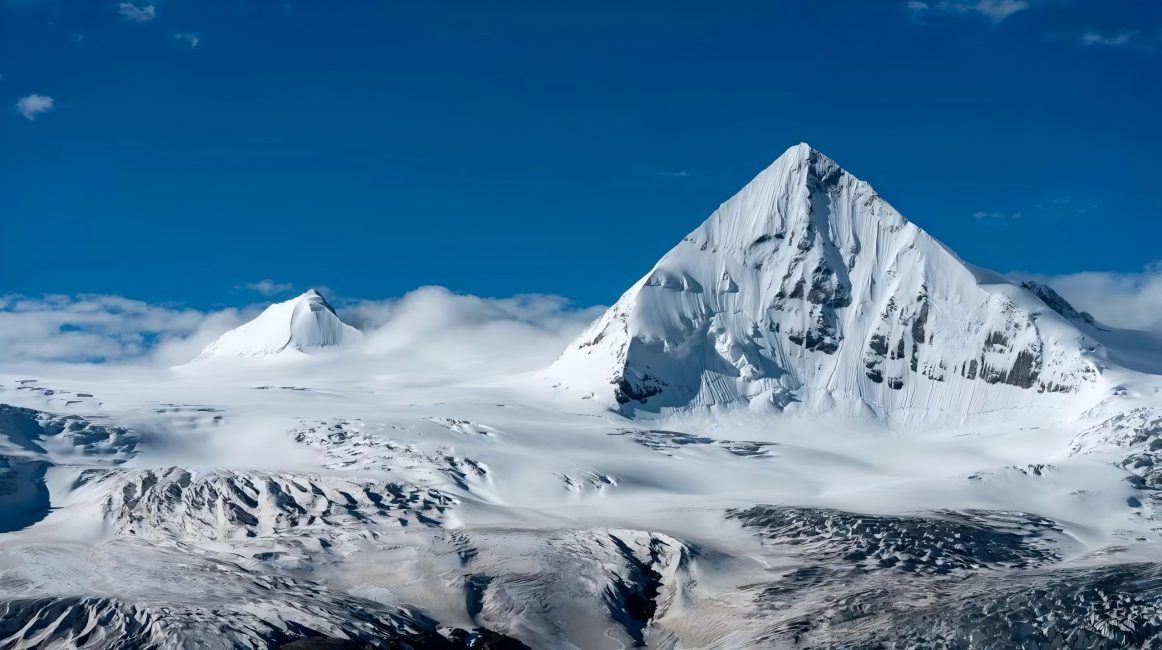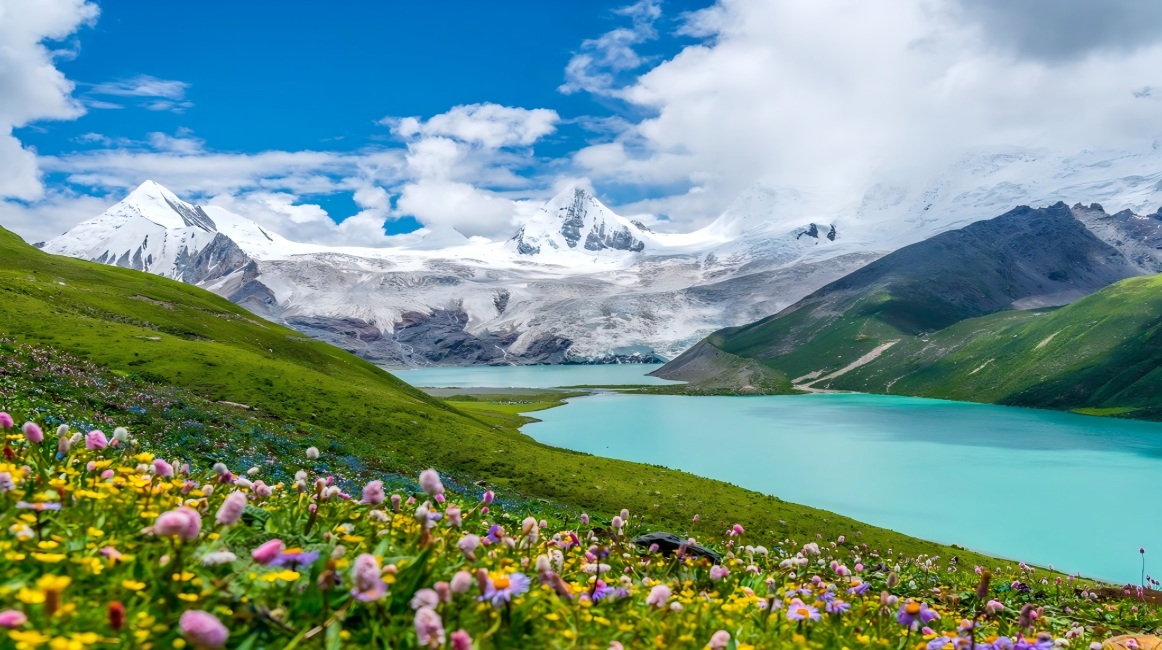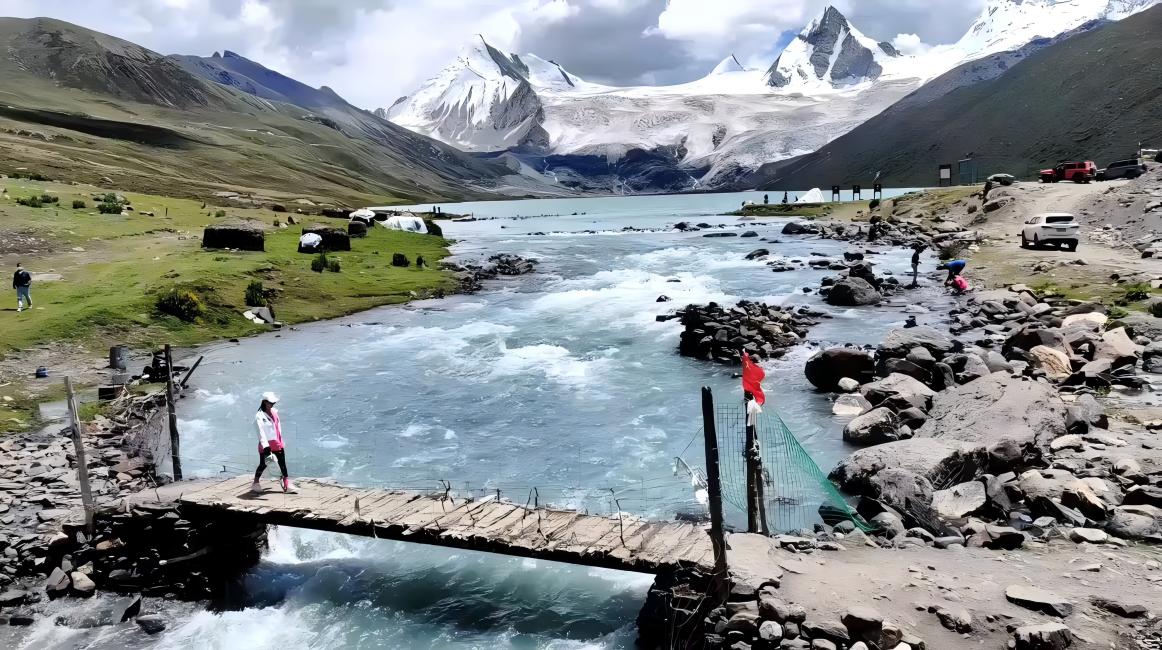The Millennium Watch of the Snow Mountain Family in Eastern Tibet's Secret Realm
Deep in the folds of the eastern Nyainqêntanglha Mountains lies a hidden treasure forgotten by time — Sapu Sacred Mountain. Straddling the border of Biru County in Nagqu and Bianba County in Qamdo, this mountain is not only the watershed between the Nu River and the Yarlung Zangbo River but also a "snow-capped Eden" integrating glacial wonders, mythological legends, and cultural heritage. Awakened by cameras only in 2016, it writes the magnificent epic of eastern Tibet's highest peak with its main peak elevation of 6,956 meters.
Natural Wonders: The Symphony of Glaciers and Lakes
Sapu's natural beauty lies in its breathtaking three-dimensional landscape. The main peak, Sapugangri, leads 12 peaks over 6,000 meters standing side by side. Among them, Galsang Tso, the "second son," and Cuotuo Tse, the "adopted son," stand out as the "most beautiful snow-capped peaks" with their perfect equilateral triangular shapes. A 6-kilometer-long marine glacier cascades down from the main peak, with a vertical drop of 2,200 meters. At the end of the ice tongue, Samtso Lake is divided into inner and outer parts: the outer lake shimmers with rippling blue waves in summer, reflecting the snow-capped peaks; the inner lake remains frozen year-round, turning into dreamy blue ice in winter where visitors can walk and touch the textures of hundreds of millions of years of glacial ice.
Even more magical is Samtso's "time code" — it thaws overnight on the 15th day of the 5th Tibetan lunar month and freezes overnight on the 15th day of the 9th lunar month, as if following an ancient agreement with the sacred mountain. In summer, Puzong Valley becomes a sea of flowers, with wildflowers carpeting the alpine meadows and yaks wandering by streams, forming a Hayao Miyazaki-style fairy-tale scene with the distant glaciers. In winter, it transforms into an Iceland-like secret realm, where black sand beaches mirror the blue ice and the Milky Way spreads across the light-pollution-free night sky, making it a paradise for astrophotography.
Historical and Cultural Heritage: Marks of Myths and Ancient Roads
Sapu's charm extends far beyond its natural scenery. In Tibetan, "Sapu" means "the depths of Snow Leopard Valley," named for the frequent snow leopard sightings in the area. It is also revered by Bon religion as "the sacred mountain of wisdom in the southern world." Local Tibetans personify the peaks, weaving warm family legends: the main peak Sapu is the dignified father, his wife Xuemo Peak stands gracefully, his daughter Beiwei Peak wears a circular ice cap (a gemstone gifted by her father), and there is even Mawogangri, the "rival peak" whose summit was split due to emotional entanglement, endowing the cold rocks with human warmth.
This sacred mountain is also a witness to history. As an important node on the Ancient Tea Horse Road, caravans, messengers, and armies have traveled along its valleys for thousands of years. Historical events such as the Qing Dynasty's "expelling the Junggar invaders to defend Tibet" and the 18th Army's entry into Tibet have left their marks here. In 1951, General Zhang Guohua led his troops through the northern foot of Sapu and camped near Sanda Monastery, forging a story of ethnic unity with local herdsmen and farmers, adding a red heritage to the sacred mountain. Every year on the 15th day of the 5th Tibetan lunar month, a grand lake circumambulation and prayer ceremony are held by Samtso Lake. Believers circle the sacred lake clockwise, with the interweaving of scriptures recitation and wind chime sounds continuing the millennium-old faith ritual.
Unique Experiences: A Carnival for Taste Buds and Journeys
Coming to Sapu, both taste buds and the soul can enjoy ultimate satisfaction. Local family hotels offer the most authentic Tibetan cuisine: Tibetan fragrant yak meat is tender and chewy, infused with the fresh flavor of Cordyceps sinensis after slow cooking, making it a nourishing delicacy on the plateau. Butter tea has a rich aroma, dispelling the cold with its salty and sweet lingering aftertaste. Tsampa needs to be kneaded by hand, mixed with butter and sugar, allowing you to experience the simple original taste of Tibetan food. If you visit in summer, you can also taste fresh yogurt and wild mushrooms, all ingredients sourced from the natural treasure trove bestowed by the sacred mountain.
Recreational activities cater to both dynamic and peaceful preferences. Hiking enthusiasts can challenge the 2-hour easy trail from the outer lake to the inner lake, passing through meadows and wetlands along the way to get up close to the moraine landforms of the glacial fracture zone. Photography enthusiasts should not miss the two iconic spots: the wooden bridge by the outer lake and the black sand beach. The golden sunlight in the morning and evening shines on the snow-capped peaks and yaks, allowing you to take stunning photos with ease. Blue ice hiking in winter, starry sky camping in summer, and the lake circumambulation festival in the 5th Tibetan lunar month — each season offers unique experiences.
Cultural Customs: The Coexistence of Daily Life and Faith
The cultural charm of Sapu lies in the daily life of the herdsmen. Only 10 Tibetan families reside permanently in the scenic area, transforming their idle houses into family hotels equipped with oxygen supply equipment, welcoming distant guests with the simplest enthusiasm. Dressed in Tibetan robes made of pulu, their faces with plateau red cheeks exude sincerity. They will take the initiative to share the legends of the sacred mountain and invite you to drink highland barley wine. At Sanda Monastery, monks will pray for visitors, with red prayer flags fluttering in front of the monastery, forming the most touching cultural picture with the distant snow-capped peaks.
There is no hustle and bustle of excessive commercialization here, only the crisp sound of yak bells, the whisper of rotating prayer wheels, and the tranquility of harmonious coexistence between humans and nature. When you sit on the terrace of a Tibetan residence, drinking butter tea and looking up at the snow-capped mountains, you will understand why Sapu is called "the last hidden gem" — it not only preserves the primitive natural scenery but also guards the pure faith and lifestyle of the Tibetan people.
A Date with the Sacred Mountain
The beauty of Sapu Sacred Mountain lies in the sharpness of glaciers, the tenderness of lakes, the romance of myths, and the profundity of faith. It boasts both Iceland-surpassing natural wonders and the cultural heritage of "eastern Tibet's Bon sacred mountain," as well as the warm human touch of daily life. Whether you are an adventurer seeking extreme scenery or a traveler longing for spiritual tranquility, this hidden gem of eastern Tibet will write an unforgettable plateau memory for you in its unique way.



